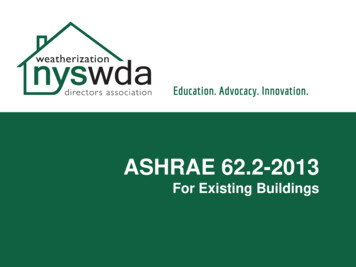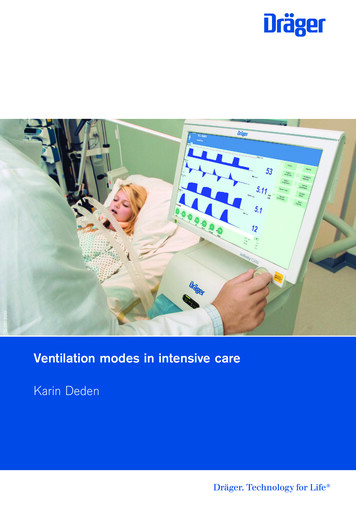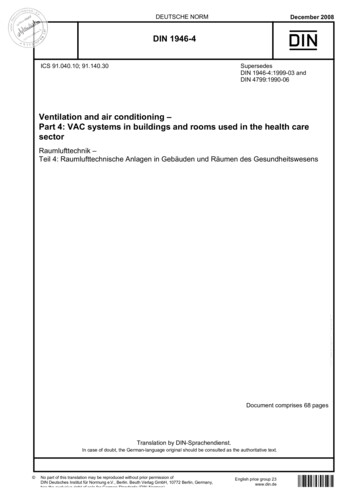
Transcription
Ventilation DesignConsiderations forPassive HouseMultifamilyResidential BuildingsHugh CrowtherVice President, EngineeringHugh.Crowther@swegon.comOctober 24, 20171Ventilation Design Considerations for Passive House Multifamily Residential Buildings
AGENDA1 Ventilation Unit Primer2 Centralized vs. Decentralized Ventilation Design3 Winter Humidity Issues4 Energy Impact - Sensible vs. Enthalpy Energy Recovery5 Summary6 Questions2Ventilation Design Considerations for Passive House Multifamily Residential Buildings
PART 1VENTILATIONUNIT PRIMERIntegrating Swegon GOLD DOAS units with Mitsubishi VRF3Ventilation Design Considerations for Passive House Multifamily Residential Buildings
ENERGY RECOVERY VENTILATION UNITSSensible Energy RecoveryTotal (Enthalpy) Energy Recovery Recover heat but not humidity Recover heat and humidity Raise temperature in winter but not increase humidity ratio Raise temperature and humidity in winter, cool anddehumidify in summer Plate, wheel, heat pipe, run around loops Sometimes called Heat Recovery Ventilators (HRVs)4Ventilation Design Considerations for Passive House Multifamily Residential Buildings Enthalpy plate enthalpy wheel Sometimes called Energy Recovery Ventilators (ERVs)
CENTRALIZED VENTILATION UNIT EXAMPLES5Ventilation Design Considerations for Passive House Multifamily Residential Buildings
DECENTRALIZED VENTILATION UNIT – WALL MOUNTED6Ventilation Design Considerations for Passive House Multifamily Residential Buildings
DECENTRALIZED VENTILATION UNITS – CLOSET/CEILING MOUNTED7Ventilation Design Considerations for Passive House Multifamily Residential Buildings
VENTILATION UNIT – PLATE TYPE8Ventilation Design Considerations for Passive House Multifamily Residential Buildings
VENTILATION UNIT – WHEEL ilation Design Considerations for Passive House Multifamily Residential BuildingsOutsideSupply
VENTILATION UNIT – WHEEL tilation Design Considerations for Passive House Multifamily Residential BuildingsOutsideSupply
VENTILATION UNIT – WHEEL tilation Design Considerations for Passive House Multifamily Residential BuildingsOutsideSupply
VENTILATION UNIT – WHEEL tilation Design Considerations for Passive House Multifamily Residential BuildingsOutsideSupply
VENTILATION UNIT – WHEEL tilation Design Considerations for Passive House Multifamily Residential BuildingsOutsideSupply
VENTILATION UNIT – WHEEL tilation Design Considerations for Passive House Multifamily Residential BuildingsOutsideSupply
VENTILATION UNIT – WHEEL tilation Design Considerations for Passive House Multifamily Residential BuildingsOutsideSupply
VENTILATION UNIT – WHEEL tilation Design Considerations for Passive House Multifamily Residential BuildingsOutsideSupply
VENTILATION UNIT – WHEEL tilation Design Considerations for Passive House Multifamily Residential BuildingsOutsideSupply
VENTILATION UNIT – WHEEL tilation Design Considerations for Passive House Multifamily Residential BuildingsOutsideSupply
DEFINITION OF EFFICIENCY (EFFECTIVENESS ETC.)𝒄𝒇𝒎𝒔𝒂(𝑿𝒐𝒂 𝑿𝒔𝒂)𝜺 𝒄𝒇𝒎𝒎𝒊𝒏(𝑿𝒐𝒂 𝑿𝒓𝒂)19𝑿𝒓𝒂 𝑿𝒆𝒂 𝑷𝒆𝒍/𝒎 · 𝒄𝒑𝜺 (𝑿𝒓𝒂 𝑿𝒐𝒂)Ventilation Design Considerations for Passive House Multifamily Residential Buildings𝜺 (𝑿𝒐𝒂 𝑿𝒔𝒂)(𝑿𝒐𝒂 𝑿𝒓𝒂)
SENSIBLE ENERGY VENTILATION UNIT (HRV)WINTER OPERATIONExhaust Air Fan23 FHeat ExchangerReturn Air FilterExhaust Air (EA)Return Air (RA)72 F 15 FOutside Air (OA)Supply Air (SA)Outside Air FilterOutdoors20Ventilation Design Considerations for Passive House Multifamily Residential BuildingsSupply Air FanIndoors65 F
TOTAL ENERGY VENTILATION UNIT (ERV)WINTER OPERATIONExhaust Air Fan23 F, 81% RH15 F, 82% RHExhaust Air (EA)Heat & MoistureExchangerReturn Air (RA) Outside Air (OA)Outside Air FilterOutdoorsPHI Certification values: 84% heat recovery efficiency (min 75% required) 0.32 W/CFM(max 0.765 required)21Return Air FilterVentilation Design Considerations for Passive House Multifamily Residential BuildingsSupply Air (SA)Supply Air FanIndoorsCertified values, no PHI requirements: 84% moisture recovery efficiency72 F, 31% RH65 F, 36% RH
TOTAL ENERGY VENTILATION UNIT (ERV)SUMMER OPERATIONExhaust Air Fan86 F, 43% RH88 F, 48% RHExhaust Air (EA)Heat & MoistureExchangerOutside Air FilterOutdoors22Return Air (RA) Outside Air (OA)PHI Certification values: None 0.32 W/CFMReturn Air Filter(min 75% required)(max 0.765 required)Ventilation Design Considerations for Passive House Multifamily Residential BuildingsSupply Air (SA)75 F, 43% RH77 F, 50% RHSupply Air FanIndoorsCertified values, no PHI requirements: 84% heat recovery (rejection) efficiency 66% moisture recovery
PART 2CENTRALIZED VS.DECENTRALIZEDVENTILATION DESIGNIntegrating Swegon GOLD DOAS units with Mitsubishi VRF23Ventilation Design Considerations for Passive House Multifamily Residential Buildings
CENTRALIZED VENTILATION DESIGN,(3) FLOORS, (1) ERV, (2) SHAFTS, (6) LONG DUCT RUNSExhaust AirRet urn AirOut side AirSupply AirOccupied SpaceOccupied SpaceOccupied Space24Ventilation Design Considerations for Passive House Multifamily Residential BuildingsPENETRATIONSERV1Outside Air1Exhaust Air1Total2
DECENTRALIZED VENTILATION DESIGN(3) FLOORS, (1) ERV/ZONE, (0) SHAFTS, SHORT DUCTSERV 1ERV 2Occupied SpaceOccupied SpaceERV 3ERV 4Occupied SpaceOccupied SpaceERV 5ERV 6Occupied Space25Occupied SpaceVentilation Design Considerations for Passive House Multifamily Residential BuildingsPENETRATIONSERV1-6Outside Air6Exhaust Air6Total12
ENERGY RECOVERY VENTILATION UNITSCentralizedDecentralized Maintenance in control of building owner Operating cost and maintenance is in tenants control Far fewer envelope penetrations (pressure testing) No common area duct runs Generally more efficient (Fans, energy recovery device) DOAS units Minimal fire damper issues Equipment noise away from tenants – easier to attenuate No Common mechanical room requirement – space savings Doesn’t use up apartment space Cost advantage - depends Cost advantage - depends26Ventilation Design Considerations for Passive House Multifamily Residential Buildings
PART 3WINTER HUMIDITYISSUESIntegrating Swegon GOLD DOAS units with Mitsubishi VRF27Ventilation Design Considerations for Passive House Multifamily Residential Buildings
WINTER HUMIDITY ISSUEHigh humidity withinapartment in cold weathercreates uncomfortableindoor climate can causecondensation to formdamage building, mold28Ventilation Design Considerations for Passive House Multifamily Residential Buildings
CONDENSATION FORMATION The colder it gets, the easierhumidity will form The higher the humidity level, theeasier humidity will form Both at the same time is a bad thing Better glass helps(inside temperature is higher andstays above dew point longer)29Ventilation Design Considerations for Passive House Multifamily Residential Buildings
SCENARIO 1 –HIGH DENSITY APARTMENT ASHRAE Std 90.1 andPassive House construction Sensible (HRV) andEnthalpy (ERV)energy recovery Decentralized andcentralized ventilation30Ventilation Design Considerations for Passive House Multifamily Residential Buildings
HIGH DENSITY APARTMENT31Ventilation Design Considerations for Passive House Multifamily Residential Buildings
HIGH DENSITY APARTMENT 952 ft² 3 bedroom, 2 bathroom Design Occupancy 4 Laundry in common area Ventilation rate 85 cfm Std 90.1 Infiltration 72 cfm PH Infiltration 20 cfm32Ventilation Design Considerations for Passive House Multifamily Residential Buildings
SCENARIO 2 –LOW DENSITY APARTMENT ASHRAE Std 90.1 andPassive House construction Sensible (HRV) andEnthalpy (ERV)energy recovery Decentralized andcentralized ventilation33Ventilation Design Considerations for Passive House Multifamily Residential Buildings
LOW DENSITY APARTMENT34Ventilation Design Considerations for Passive House Multifamily Residential Buildings
LOW DENSITY APARTMENT 853 ft² 2 bedroom, 2 bathroom Design Occupancy 4 Laundry in apartment Ventilation rate 85 cfm Std 90.1 Infiltration 141cfm PH Infiltration 39 cfm35Ventilation Design Considerations for Passive House Multifamily Residential Buildings
ESTIMATING HUMIDITY LOADS36Ventilation Design Considerations for Passive House Multifamily Residential Buildings
ESTIMATING HUMIDITY LOADS*SourcePintsGrains5 Minute Shower0.53650Indoor drying of cloths4-6 per load29225-43840 per load5-7 house plants1/day7300/dayWashing Dishes (Dinner, family of 4)0.75100Cooking (Dinner, Family of 4)1.2(1.5 with gas cooktop)8770(10950 with gas ration, New Construction Materials10 /day73000 /day1 Cord Green Firewood, stoed indoors for 6 mo400-8002.9M-5.8M*Minnesota Extension Service, University of Minnesota37Ventilation Design Considerations for Passive House Multifamily Residential Buildings
HUMIDITY SOURCE ASSUMPTIONS38High Density8770 gr/hHigh Density59.1 gr/lbHigh Density7300 gr/hLow Density8770 gr/hLow Density52.7 gr/lbLow Density3650 gr/hHigh Density5100 gr/hHigh Density12160 gr/hLow Density5100 gr/hLow Density9120 gr/hVentilation Design Considerations for Passive House Multifamily Residential Buildings
DEHUMIDIFICATION Air Infiltration 0.18 cfm/ft2@ 0.2” wc (Std 90.1) 0.05 cfm/ft2@ 0.2’wc (PH) Permeation – ignored Ventilation air 85 cfm Sensible Energy Recovery(dry air) Total Energy Recovery(retain 80% of moisture)39Ventilation Design Considerations for Passive House Multifamily Residential Buildings
Sensible (HRV) Energy tionSensibleEnergyRecoveryVentilationNew HumRatio 72FNew Rel.Hum. at72Fgr/hrgr/hrgr/hrgr/lb%Std 90.1Construction33330624073675850.5Passive HouseConstruction33330173373676656.5 Infiltration from Std 90.1 constructionhelps dry out space Sensible recovery device recovers heatbut air is dry – helps dry out spaceResultHumidityGainInfiltrationTotal Energy New HumRecoveryRatio 72FVentilationNew Rel.Hum. at72Fgr/hrgr/hrgr/hrgr/lb%Std 90.1Construction33330624014736959Passive HouseConstruction33330173314737765.740 HIGH DENSITY APARTMENT HAS highinternal humidity gain Tight PH building builds up humidity inspaceTotal (ERV) Energy RecoveryDehumidificationSCENARIO 1 – HIGH DENSITY,DECENTRALIZED VENTILATIONVentilation Design Considerations for Passive House Multifamily Residential Buildings Total energy recovery device recoups80% of humidity – causes humidity toincrease
Sensible (HRV) Energy tionSensibleEnergyRecoveryVentilationNew HumRatio 72FNew Rel.Hum. at72Fgr/hrgr/hrgr/hrgr/lb%Std 90.1Construction33330624073675850.5Passive HouseConstruction33330173373676656.5 Infiltration from Std 90.1 constructionhelps dry out space Centralized sensible energy devicebehaves the same as decentralizedResultHumidityGainInfiltrationTotal Energy New HumRecoveryRatio 72FVentilationNew Rel.Hum. at72Fgr/hrgr/hrgr/hrgr/lb%Std 90.1Construction33330624029476656.5Passive HouseConstruction33330173329477463.641 High Density apartment has high internalhumidity gain Tight PH building builds up humidity inspaceTotal (ERV) Energy RecoveryDehumidificationSCENARIO 1 – HIGH DENSITY,CENTRALIZED VENTILATIONVentilation Design Considerations for Passive House Multifamily Residential Buildings Diversity from being connected tomultiple apartments reduces increase inRH
Sensible (HRV) Energy tionSensibleEnergyRecoveryVentilationNew HumRatio 72FNew Rel.Hum. at72Fgr/hrgr/hrgr/hrgr/lb%Std 90.1Construction266401223073673731.9Passive HouseConstruction26640339773675547.2 Infiltration from Std 90.1 constructionhelps dry out space Sensible recovery device recovers heatbut air is dry – helps dry out spaceResultHumidityGainInfiltrationTotal Energy New HumRecoveryRatio 72FVentilationNew Rel.Hum. at72Fgr/hrgr/hrgr/hrgr/lb%Std 90.1Construction2664012230.473676942Passive HouseConstruction26640339773676656.542 Low density apartment has 80%humidity gain for same volume Tight PH building builds up humidity inspaceTotal (ERV) Energy RecoveryDehumidificationSCENARIO 2 – LOW DENSITY,DECENTRALIZED VENTILATIONVentilation Design Considerations for Passive House Multifamily Residential Buildings Total energy recovery device recoups80% of humidity – but not to anunacceptable level
Sensible (HRV) Energy tionSensibleEnergyRecoveryVentilationNew HumRatio 72FNew Rel.Hum. at72Fgr/hrgr/hrgr/hrgr/lb%Std 90.1Construction266401223073673731.9Passive HouseConstruction26640339773675547.2 Infiltration from Std 90.1 constructionhelps dry out space Centralized sensible energy devicebehaves the same as decentralizedResultHumidityGainInfiltrationTotal Energy New HumRecoveryRatio 72FVentilationNew Rel.Hum. at72Fgr/hrgr/hrgr/hrgr/lb%Std 90.1Construction2664012230.473676639.5Passive HouseConstruction26640339773676353.943 Low density apartment has 80%humidity gain for same volume Tight PH building builds up humidity inspaceTotal (ERV) Energy RecoveryDehumidificationSCENARIO 2 – LOW DENSITY,CENTRALIZED VENTILATIONVentilation Design Considerations for Passive House Multifamily Residential Buildings Diversity from being connected tomultiple apartments and lower humiditygain make total energy preferable
4LOWCENTRALIZEDSensiblePHPHVentilation Design Considerations for Passive House Multifamily Residential New Rel. Hum. At 72F (%)Total90.11Sensible vs. ensible47.2Total53.9
WINTER HUMIDITY SUMMARYPassive Houseconstruction is tightUltra low leakage rates cancause humidity to build upin apartments especiallyhigh density apartments45Decentralized TotalEnergy RecoveryVentilation has riskHumidity recovery causeshumidity to build up tounacceptable levels.It may not be an issue inlow density apartmentsVentilation Design Considerations for Passive House Multifamily Residential BuildingsCentralized Ventilationunits can helpThe diversity fromconnecting to multipleapartments can reducehumidity build up andallow additional savingsfrom total energy recovery
PART 4ENERGY IMPACT –SENSIBLE VS.ENTHALPY ENERGYRECOVERYIntegrating Swegon GOLD DOAS units with Mitsubishi VRF46Ventilation Design Considerations for Passive House Multifamily Residential Buildings
ENERGY MODELLING DOAS unit energy modelling program Compare two systems side by side Enthalpy Wheel vs. sensible wheel Scenario 1 – No cooling, hot waterheating Scenario 2 - VRF DX cooling w/ HGRHand heat pump heating47Ventilation Design Considerations for Passive House Multifamily Residential Buildings
MODEL SETUP48Ventilation Design Considerations for Passive House Multifamily Residential Buildings
MODEL SETUP49Ventilation Design Considerations for Passive House Multifamily Residential Buildings
WHEEL FROST CONTROLTotal recovery much greater than sensible due to lower frost pointAlmost twice winter energy recovery50Ventilation Design Considerations for Passive House Multifamily Residential BuildingsWheel speed vs. energy transfer not linearMust slow wheel down to a few rpm to getcapacity reduction
SCENARIO 1- NO COOLING51Ventilation Design Considerations for Passive House Multifamily Residential Buildings
Scenario 2 - VRF Heating and Cooling52Ventilation Design Considerations for Passive House Multifamily Residential Buildings
VRF – Ventilation Unit Integrated Controls53Ventilation Design Considerations for Passive House Multifamily Residential Buildings
VRF Electronic Expansion Devices54Ventilation Design Considerations for Passive House Multifamily Residential Buildings
VRF – Hot Gas Reheat Solution55Ventilation Design Considerations for Passive House Multifamily Residential Buildings
SCENARIO 2 - VRF COOLING AND HEATING56Ventilation Design Considerations for Passive House Multifamily Residential Buildings
PART 5SUMMARY57Ventilation Design Considerations for Passive House Multifamily Residential Buildings
SUMMARYCentralized vs. decentralizedventilation depends on theapplicationPassive House constructionand high humidity in wintershould be consideredTotal Energy recoverysaves energy and reducesoperating costThe are many parametersincluding technical and costthat impact this decision.Being able to seal the buildingfor a pressure test should notbe overlooked especially ontall buildingsBe careful with high densityapartments and decentralizedtotal energy recovery.Centralized total energyrecovery should be okay, Lowdensity apartments should beokay but check!Total energy recovers5-15% more sensibleenergy in winter plusmaintain indoor humidity.It dehumidifies in summer.It reduces size of airconditioning by 25%58Ventilation Design Considerations for Passive House Multifamily Residential Buildings
Questions?59Ventilation Design Considerations for Passive House Multifamily Residential Buildings
21 Ventilation Design Considerations for Passive House Multifamily Residential Buildings TOTAL ENERGY VENTILATION UNIT (ERV) WINTER OPERATION Outside Air (OA) Exhaust Air (EA) Supply Air (SA) Return Air (RA) 15 F, 82% RH 65 F, 36% RH 23 F, 81% RH 72 F, 31% RH Exhaust Air Fan Heat & Moisture Exchanger Return Air Filter










